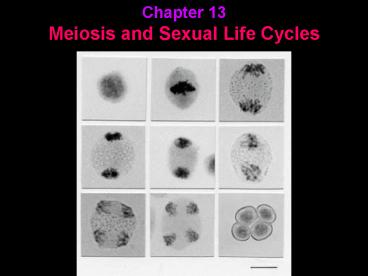Chapter 13 Meiosis and Sexual Life Cycles - PowerPoint PPT Presentation
1 / 42
Title:
Chapter 13 Meiosis and Sexual Life Cycles
Description:
Chapter 13 Meiosis and Sexual Life Cycles Meiosis differs from mitosis in three ways: Chapter 13 Meiosis and Sexual Life Cycles Synapsis Crossing over Separating ... – PowerPoint PPT presentation
Number of Views:386
Avg rating:3.0/5.0
Title: Chapter 13 Meiosis and Sexual Life Cycles
1
Chapter 13Meiosis and Sexual Life Cycles
2
Chapter 13Meiosis and Sexual Life Cycles
- Why
- sex?
3
Chapter 13Meiosis and Sexual Life Cycles
- Diversity
4
Chapter 13Meiosis and Sexual Life Cycles
- Four organisms
5
Chapter 13Meiosis and Sexual Life Cycles
This mutation protects against disease
- Four organisms
6
Chapter 13Meiosis and Sexual Life Cycles
This mutation protects against disease
This mutation protects against cold
- Four organisms
7
Chapter 13Meiosis and Sexual Life Cycles
- They reproduce asexually
8
Chapter 13Meiosis and Sexual Life Cycles
- They reproduce asexually
9
Chapter 13Meiosis and Sexual Life Cycles
- They reproduce asexually
10
Chapter 13Meiosis and Sexual Life Cycles
- A disease comes
11
Chapter 13Meiosis and Sexual Life Cycles
- A disease comes
12
Chapter 13Meiosis and Sexual Life Cycles
- Then it gets cold
13
Chapter 13Meiosis and Sexual Life Cycles
- Then it gets cold
14
Chapter 13Meiosis and Sexual Life Cycles
- What if they reproduced sexually?
15
Chapter 13Meiosis and Sexual Life Cycles
- What if they reproduced sexually?
16
Chapter 13Meiosis and Sexual Life Cycles
- What if they reproduced sexually?
17
Chapter 13Meiosis and Sexual Life Cycles
- What if they reproduced sexually?
18
Chapter 13Meiosis and Sexual Life Cycles
- What if they reproduced sexually?
19
Chapter 13Meiosis and Sexual Life Cycles
- A disease comes
20
Chapter 13Meiosis and Sexual Life Cycles
- A disease comes
21
Chapter 13Meiosis and Sexual Life Cycles
- Then it gets cold
22
Chapter 13Meiosis and Sexual Life Cycles
- Then it gets cold
23
Chapter 13Meiosis and Sexual Life Cycles
- The population with the most diversity is the
most likely to leave survivors after
unpredictable changes.
24
Chapter 13Meiosis and Sexual Life Cycles
- Each gene has a specific location on a specific
chromosome.
25
Chapter 13Meiosis and Sexual Life Cycles
- We inherit one set of chromosomes from our father
and one set from our mother.
26
Chapter 13Meiosis and Sexual Life Cycles
- Asexual
- Sexual
27
Chapter 13Meiosis and Sexual Life Cycles
- Asexual reproduction produces genetically
identical offspring by mitosis. - Sexual reproduction produces genetically diverse
offspring.
28
Chapter 13Meiosis and Sexual Life Cycles
- In humans,
- 2n 46
- n 23
29
Chapter 13Meiosis and Sexual Life Cycles
- In humans,
- 2n 46
- n 23
- 22 pairs are homologous, the 23rd pair is either
XX or XY.
30
Chapter 13Meiosis and Sexual Life Cycles
- Gonads (testes and ovaries) produce haploid
gametes by meiosis
31
Chapter 13Meiosis and Sexual Life Cycles
- Gonads (testes and ovaries) produce haploid
gametes by meiosis. - Sperm and ovum unite to form a diploid zygote,
which grows and develops by mitosis.
32
Chapter 13Meiosis and Sexual Life Cycles
- Sexual life cycles differ in the timing of
meiosis in relation to fertilization
33
Chapter 13Meiosis and Sexual Life Cycles
- Sexual life cycles differ in the timing of
meiosis in relation to fertilization. - Multicellular organisms may be diploid or haploid
or may alternate between haploid and diploid
generations.
34
Chapter 13Meiosis and Sexual Life Cycles
- Meiosis differs from mitosis in three ways
- Synapsis
- Crossing over
- Separating homologous pairs (not sister
chromatids) during anaphase I.
35
Chapter 13Meiosis and Sexual Life Cycles
36
Chapter 13Meiosis and Sexual Life Cycles
37
Chapter 13Meiosis and Sexual Life Cycles
38
Chapter 13Meiosis and Sexual Life Cycles
39
Chapter 13Meiosis and Sexual Life Cycles
- Genetic variation is the raw material for
evolution
40
Chapter 13Meiosis and Sexual Life Cycles
- Genetic variation is the raw material for
evolution. - Mutations create variation
41
Chapter 13Meiosis and Sexual Life Cycles
- Genetic variation is the raw material for
evolution. - Mutations create variation.
- Sexual reproduction promotes variation.
42
Chapter 13Meiosis and Sexual Life Cycles
- Sexual reproduction promotes variation three ways
- Independent assortment of chromosomes during
meiosis - Crossing over during metaphase I
- Random fertilization of egg cells by sperm.
- .































